Comprehensive Study of Theories, Principles and Models in E&T: Report
VerifiedAdded on 2020/07/22
|15
|5372
|129
Report
AI Summary
This report delves into the core concepts of education and training, examining various theories, principles, and models. It begins by defining learning and exploring different learning theories, including behaviorism, cognitive theory, social learning theory, and constructivist approaches, and how they apply to teaching, learning, and assessment. The report further investigates individual learning preferences, such as the VARK model and Honey and Mumford learning styles, emphasizing inclusive teaching practices. It then discusses theories and models of assessment, including structured and unstructured methods, along with examples of completed student assessments. The report also covers curriculum development theories and models and how they can be applied in educational settings. Finally, it addresses theories and models of reflection and evaluation, providing a comprehensive overview of educational practices. The report aims to provide insight into the application of these concepts in creating effective learning environments.
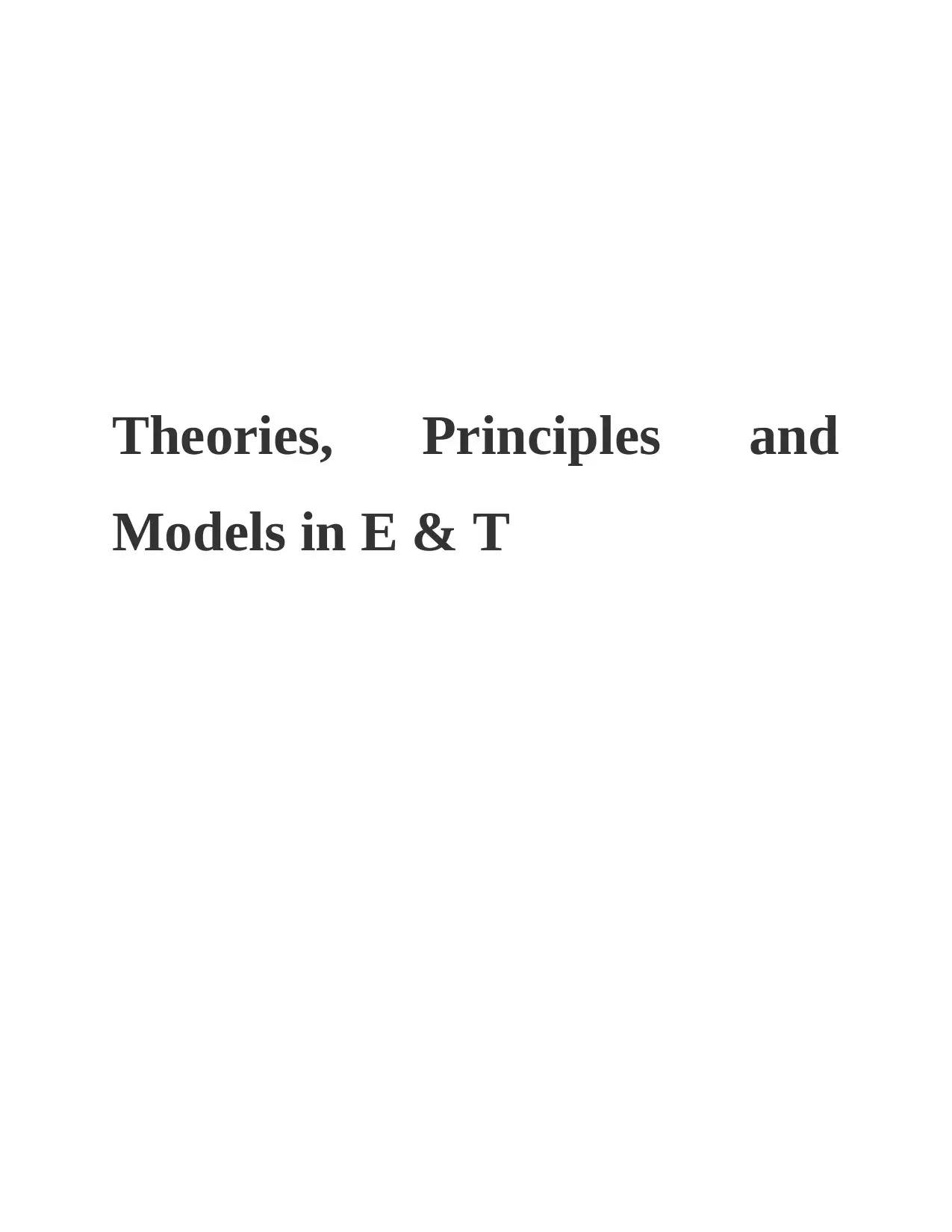
Theories, Principles and
Models in E & T
Models in E & T
Paraphrase This Document
Need a fresh take? Get an instant paraphrase of this document with our AI Paraphraser
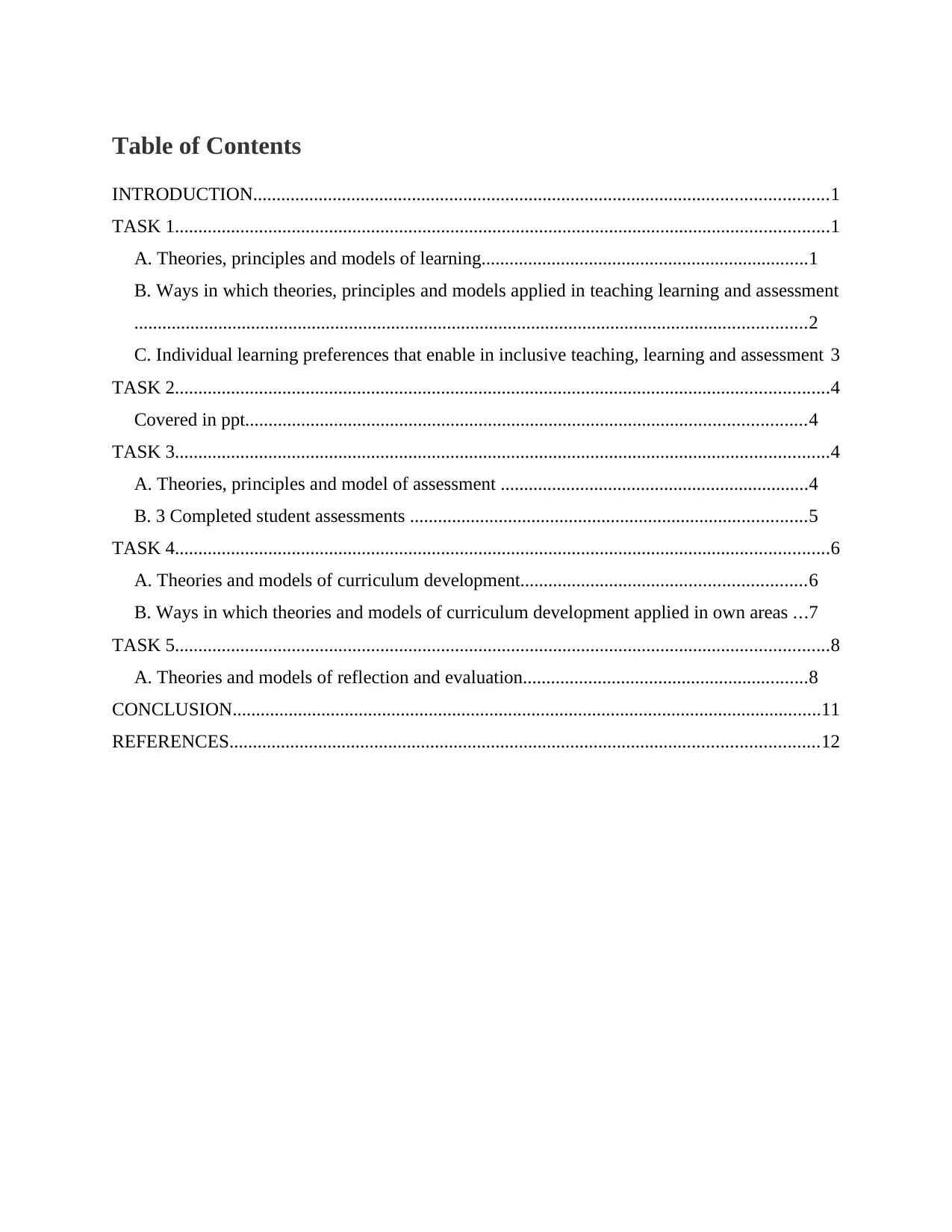
Table of Contents
INTRODUCTION...........................................................................................................................1
TASK 1............................................................................................................................................1
A. Theories, principles and models of learning......................................................................1
B. Ways in which theories, principles and models applied in teaching learning and assessment
................................................................................................................................................2
C. Individual learning preferences that enable in inclusive teaching, learning and assessment 3
TASK 2............................................................................................................................................4
Covered in ppt........................................................................................................................4
TASK 3............................................................................................................................................4
A. Theories, principles and model of assessment ..................................................................4
B. 3 Completed student assessments .....................................................................................5
TASK 4............................................................................................................................................6
A. Theories and models of curriculum development.............................................................6
B. Ways in which theories and models of curriculum development applied in own areas ...7
TASK 5............................................................................................................................................8
A. Theories and models of reflection and evaluation.............................................................8
CONCLUSION..............................................................................................................................11
REFERENCES..............................................................................................................................12
INTRODUCTION...........................................................................................................................1
TASK 1............................................................................................................................................1
A. Theories, principles and models of learning......................................................................1
B. Ways in which theories, principles and models applied in teaching learning and assessment
................................................................................................................................................2
C. Individual learning preferences that enable in inclusive teaching, learning and assessment 3
TASK 2............................................................................................................................................4
Covered in ppt........................................................................................................................4
TASK 3............................................................................................................................................4
A. Theories, principles and model of assessment ..................................................................4
B. 3 Completed student assessments .....................................................................................5
TASK 4............................................................................................................................................6
A. Theories and models of curriculum development.............................................................6
B. Ways in which theories and models of curriculum development applied in own areas ...7
TASK 5............................................................................................................................................8
A. Theories and models of reflection and evaluation.............................................................8
CONCLUSION..............................................................................................................................11
REFERENCES..............................................................................................................................12
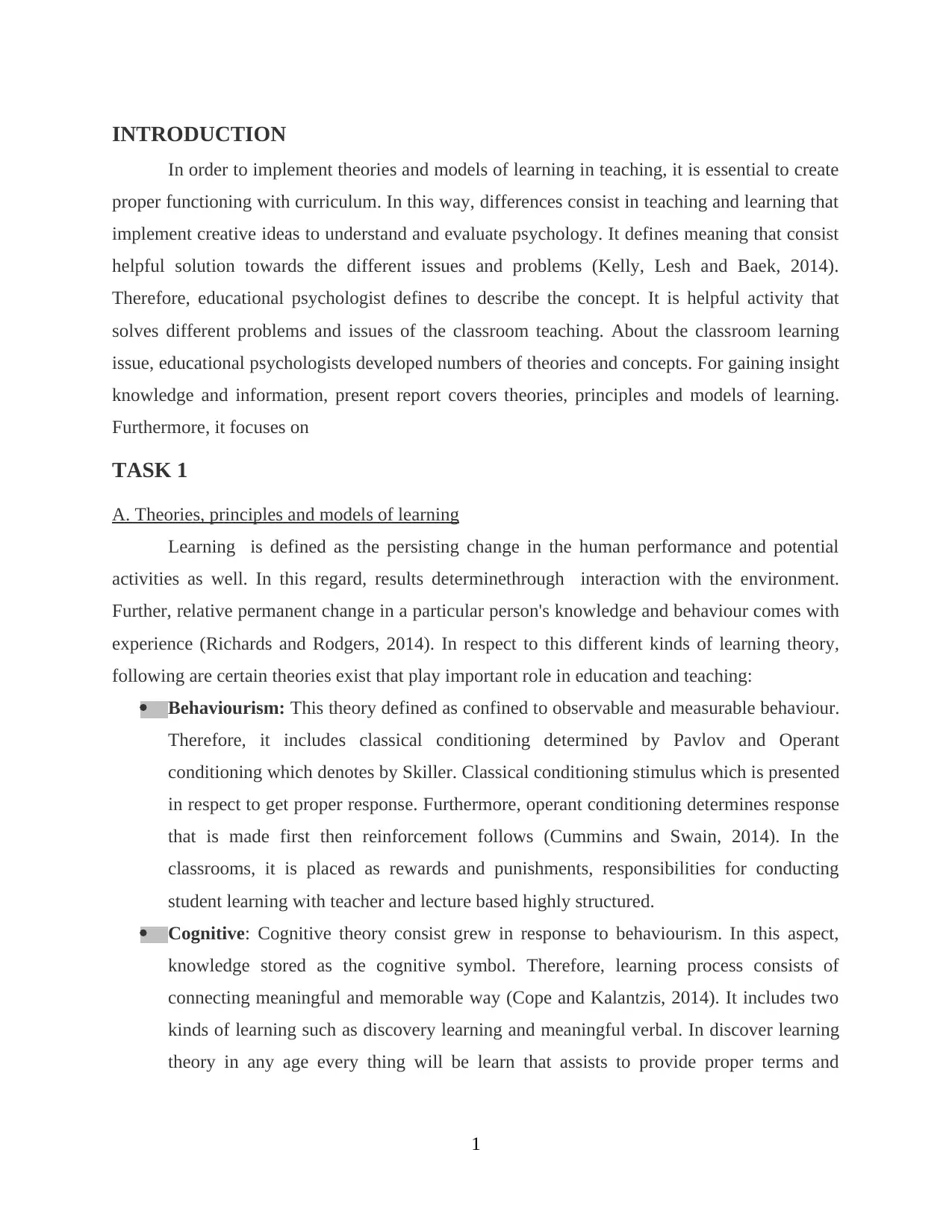
INTRODUCTION
In order to implement theories and models of learning in teaching, it is essential to create
proper functioning with curriculum. In this way, differences consist in teaching and learning that
implement creative ideas to understand and evaluate psychology. It defines meaning that consist
helpful solution towards the different issues and problems (Kelly, Lesh and Baek, 2014).
Therefore, educational psychologist defines to describe the concept. It is helpful activity that
solves different problems and issues of the classroom teaching. About the classroom learning
issue, educational psychologists developed numbers of theories and concepts. For gaining insight
knowledge and information, present report covers theories, principles and models of learning.
Furthermore, it focuses on
TASK 1
A. Theories, principles and models of learning
Learning is defined as the persisting change in the human performance and potential
activities as well. In this regard, results determinethrough interaction with the environment.
Further, relative permanent change in a particular person's knowledge and behaviour comes with
experience (Richards and Rodgers, 2014). In respect to this different kinds of learning theory,
following are certain theories exist that play important role in education and teaching:
Behaviourism: This theory defined as confined to observable and measurable behaviour.
Therefore, it includes classical conditioning determined by Pavlov and Operant
conditioning which denotes by Skiller. Classical conditioning stimulus which is presented
in respect to get proper response. Furthermore, operant conditioning determines response
that is made first then reinforcement follows (Cummins and Swain, 2014). In the
classrooms, it is placed as rewards and punishments, responsibilities for conducting
student learning with teacher and lecture based highly structured.
Cognitive: Cognitive theory consist grew in response to behaviourism. In this aspect,
knowledge stored as the cognitive symbol. Therefore, learning process consists of
connecting meaningful and memorable way (Cope and Kalantzis, 2014). It includes two
kinds of learning such as discovery learning and meaningful verbal. In discover learning
theory in any age every thing will be learn that assists to provide proper terms and
1
In order to implement theories and models of learning in teaching, it is essential to create
proper functioning with curriculum. In this way, differences consist in teaching and learning that
implement creative ideas to understand and evaluate psychology. It defines meaning that consist
helpful solution towards the different issues and problems (Kelly, Lesh and Baek, 2014).
Therefore, educational psychologist defines to describe the concept. It is helpful activity that
solves different problems and issues of the classroom teaching. About the classroom learning
issue, educational psychologists developed numbers of theories and concepts. For gaining insight
knowledge and information, present report covers theories, principles and models of learning.
Furthermore, it focuses on
TASK 1
A. Theories, principles and models of learning
Learning is defined as the persisting change in the human performance and potential
activities as well. In this regard, results determinethrough interaction with the environment.
Further, relative permanent change in a particular person's knowledge and behaviour comes with
experience (Richards and Rodgers, 2014). In respect to this different kinds of learning theory,
following are certain theories exist that play important role in education and teaching:
Behaviourism: This theory defined as confined to observable and measurable behaviour.
Therefore, it includes classical conditioning determined by Pavlov and Operant
conditioning which denotes by Skiller. Classical conditioning stimulus which is presented
in respect to get proper response. Furthermore, operant conditioning determines response
that is made first then reinforcement follows (Cummins and Swain, 2014). In the
classrooms, it is placed as rewards and punishments, responsibilities for conducting
student learning with teacher and lecture based highly structured.
Cognitive: Cognitive theory consist grew in response to behaviourism. In this aspect,
knowledge stored as the cognitive symbol. Therefore, learning process consists of
connecting meaningful and memorable way (Cope and Kalantzis, 2014). It includes two
kinds of learning such as discovery learning and meaningful verbal. In discover learning
theory in any age every thing will be learn that assists to provide proper terms and
1
⊘ This is a preview!⊘
Do you want full access?
Subscribe today to unlock all pages.

Trusted by 1+ million students worldwide
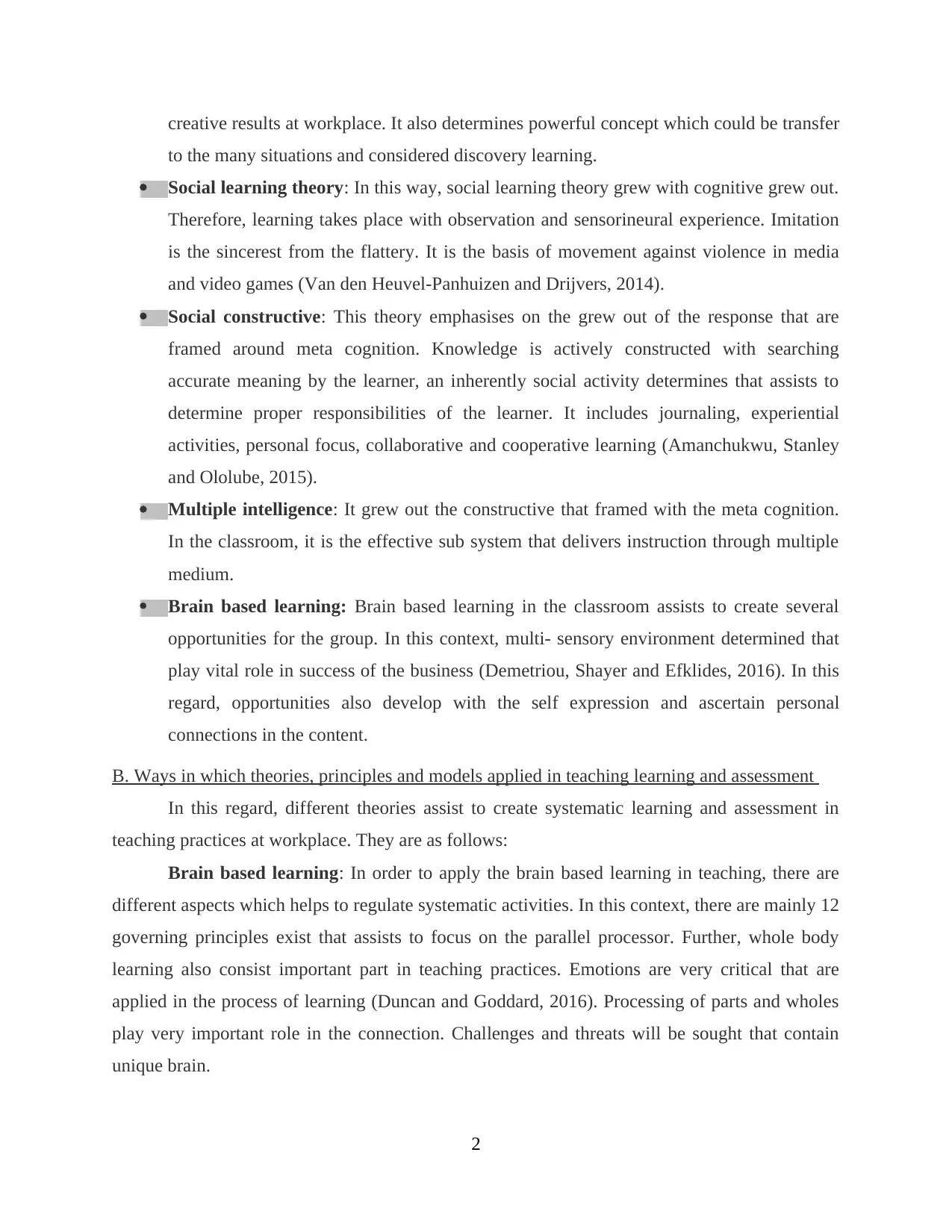
creative results at workplace. It also determines powerful concept which could be transfer
to the many situations and considered discovery learning.
Social learning theory: In this way, social learning theory grew with cognitive grew out.
Therefore, learning takes place with observation and sensorineural experience. Imitation
is the sincerest from the flattery. It is the basis of movement against violence in media
and video games (Van den Heuvel-Panhuizen and Drijvers, 2014).
Social constructive: This theory emphasises on the grew out of the response that are
framed around meta cognition. Knowledge is actively constructed with searching
accurate meaning by the learner, an inherently social activity determines that assists to
determine proper responsibilities of the learner. It includes journaling, experiential
activities, personal focus, collaborative and cooperative learning (Amanchukwu, Stanley
and Ololube, 2015).
Multiple intelligence: It grew out the constructive that framed with the meta cognition.
In the classroom, it is the effective sub system that delivers instruction through multiple
medium.
Brain based learning: Brain based learning in the classroom assists to create several
opportunities for the group. In this context, multi- sensory environment determined that
play vital role in success of the business (Demetriou, Shayer and Efklides, 2016). In this
regard, opportunities also develop with the self expression and ascertain personal
connections in the content.
B. Ways in which theories, principles and models applied in teaching learning and assessment
In this regard, different theories assist to create systematic learning and assessment in
teaching practices at workplace. They are as follows:
Brain based learning: In order to apply the brain based learning in teaching, there are
different aspects which helps to regulate systematic activities. In this context, there are mainly 12
governing principles exist that assists to focus on the parallel processor. Further, whole body
learning also consist important part in teaching practices. Emotions are very critical that are
applied in the process of learning (Duncan and Goddard, 2016). Processing of parts and wholes
play very important role in the connection. Challenges and threats will be sought that contain
unique brain.
2
to the many situations and considered discovery learning.
Social learning theory: In this way, social learning theory grew with cognitive grew out.
Therefore, learning takes place with observation and sensorineural experience. Imitation
is the sincerest from the flattery. It is the basis of movement against violence in media
and video games (Van den Heuvel-Panhuizen and Drijvers, 2014).
Social constructive: This theory emphasises on the grew out of the response that are
framed around meta cognition. Knowledge is actively constructed with searching
accurate meaning by the learner, an inherently social activity determines that assists to
determine proper responsibilities of the learner. It includes journaling, experiential
activities, personal focus, collaborative and cooperative learning (Amanchukwu, Stanley
and Ololube, 2015).
Multiple intelligence: It grew out the constructive that framed with the meta cognition.
In the classroom, it is the effective sub system that delivers instruction through multiple
medium.
Brain based learning: Brain based learning in the classroom assists to create several
opportunities for the group. In this context, multi- sensory environment determined that
play vital role in success of the business (Demetriou, Shayer and Efklides, 2016). In this
regard, opportunities also develop with the self expression and ascertain personal
connections in the content.
B. Ways in which theories, principles and models applied in teaching learning and assessment
In this regard, different theories assist to create systematic learning and assessment in
teaching practices at workplace. They are as follows:
Brain based learning: In order to apply the brain based learning in teaching, there are
different aspects which helps to regulate systematic activities. In this context, there are mainly 12
governing principles exist that assists to focus on the parallel processor. Further, whole body
learning also consist important part in teaching practices. Emotions are very critical that are
applied in the process of learning (Duncan and Goddard, 2016). Processing of parts and wholes
play very important role in the connection. Challenges and threats will be sought that contain
unique brain.
2
Paraphrase This Document
Need a fresh take? Get an instant paraphrase of this document with our AI Paraphraser
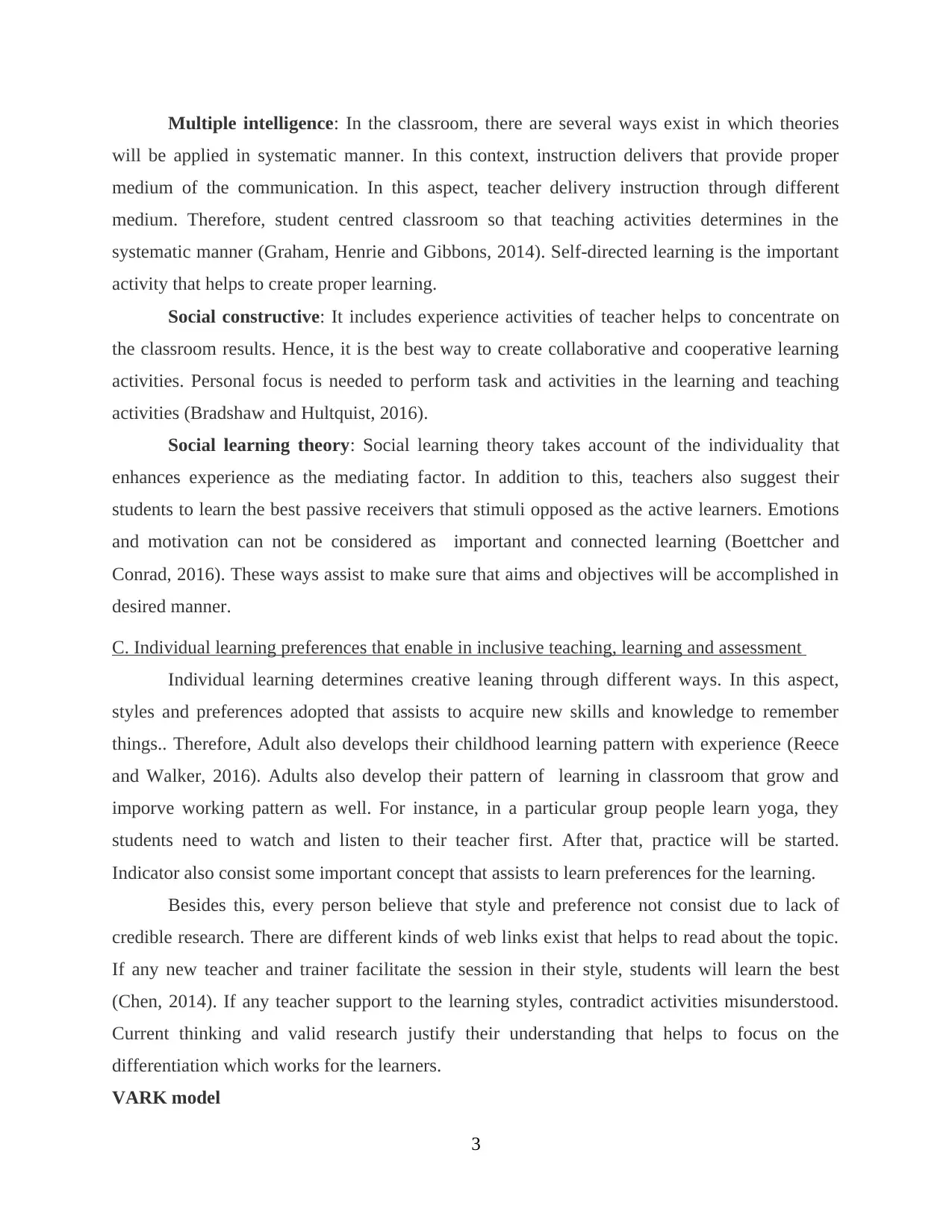
Multiple intelligence: In the classroom, there are several ways exist in which theories
will be applied in systematic manner. In this context, instruction delivers that provide proper
medium of the communication. In this aspect, teacher delivery instruction through different
medium. Therefore, student centred classroom so that teaching activities determines in the
systematic manner (Graham, Henrie and Gibbons, 2014). Self-directed learning is the important
activity that helps to create proper learning.
Social constructive: It includes experience activities of teacher helps to concentrate on
the classroom results. Hence, it is the best way to create collaborative and cooperative learning
activities. Personal focus is needed to perform task and activities in the learning and teaching
activities (Bradshaw and Hultquist, 2016).
Social learning theory: Social learning theory takes account of the individuality that
enhances experience as the mediating factor. In addition to this, teachers also suggest their
students to learn the best passive receivers that stimuli opposed as the active learners. Emotions
and motivation can not be considered as important and connected learning (Boettcher and
Conrad, 2016). These ways assist to make sure that aims and objectives will be accomplished in
desired manner.
C. Individual learning preferences that enable in inclusive teaching, learning and assessment
Individual learning determines creative leaning through different ways. In this aspect,
styles and preferences adopted that assists to acquire new skills and knowledge to remember
things.. Therefore, Adult also develops their childhood learning pattern with experience (Reece
and Walker, 2016). Adults also develop their pattern of learning in classroom that grow and
imporve working pattern as well. For instance, in a particular group people learn yoga, they
students need to watch and listen to their teacher first. After that, practice will be started.
Indicator also consist some important concept that assists to learn preferences for the learning.
Besides this, every person believe that style and preference not consist due to lack of
credible research. There are different kinds of web links exist that helps to read about the topic.
If any new teacher and trainer facilitate the session in their style, students will learn the best
(Chen, 2014). If any teacher support to the learning styles, contradict activities misunderstood.
Current thinking and valid research justify their understanding that helps to focus on the
differentiation which works for the learners.
VARK model
3
will be applied in systematic manner. In this context, instruction delivers that provide proper
medium of the communication. In this aspect, teacher delivery instruction through different
medium. Therefore, student centred classroom so that teaching activities determines in the
systematic manner (Graham, Henrie and Gibbons, 2014). Self-directed learning is the important
activity that helps to create proper learning.
Social constructive: It includes experience activities of teacher helps to concentrate on
the classroom results. Hence, it is the best way to create collaborative and cooperative learning
activities. Personal focus is needed to perform task and activities in the learning and teaching
activities (Bradshaw and Hultquist, 2016).
Social learning theory: Social learning theory takes account of the individuality that
enhances experience as the mediating factor. In addition to this, teachers also suggest their
students to learn the best passive receivers that stimuli opposed as the active learners. Emotions
and motivation can not be considered as important and connected learning (Boettcher and
Conrad, 2016). These ways assist to make sure that aims and objectives will be accomplished in
desired manner.
C. Individual learning preferences that enable in inclusive teaching, learning and assessment
Individual learning determines creative leaning through different ways. In this aspect,
styles and preferences adopted that assists to acquire new skills and knowledge to remember
things.. Therefore, Adult also develops their childhood learning pattern with experience (Reece
and Walker, 2016). Adults also develop their pattern of learning in classroom that grow and
imporve working pattern as well. For instance, in a particular group people learn yoga, they
students need to watch and listen to their teacher first. After that, practice will be started.
Indicator also consist some important concept that assists to learn preferences for the learning.
Besides this, every person believe that style and preference not consist due to lack of
credible research. There are different kinds of web links exist that helps to read about the topic.
If any new teacher and trainer facilitate the session in their style, students will learn the best
(Chen, 2014). If any teacher support to the learning styles, contradict activities misunderstood.
Current thinking and valid research justify their understanding that helps to focus on the
differentiation which works for the learners.
VARK model
3
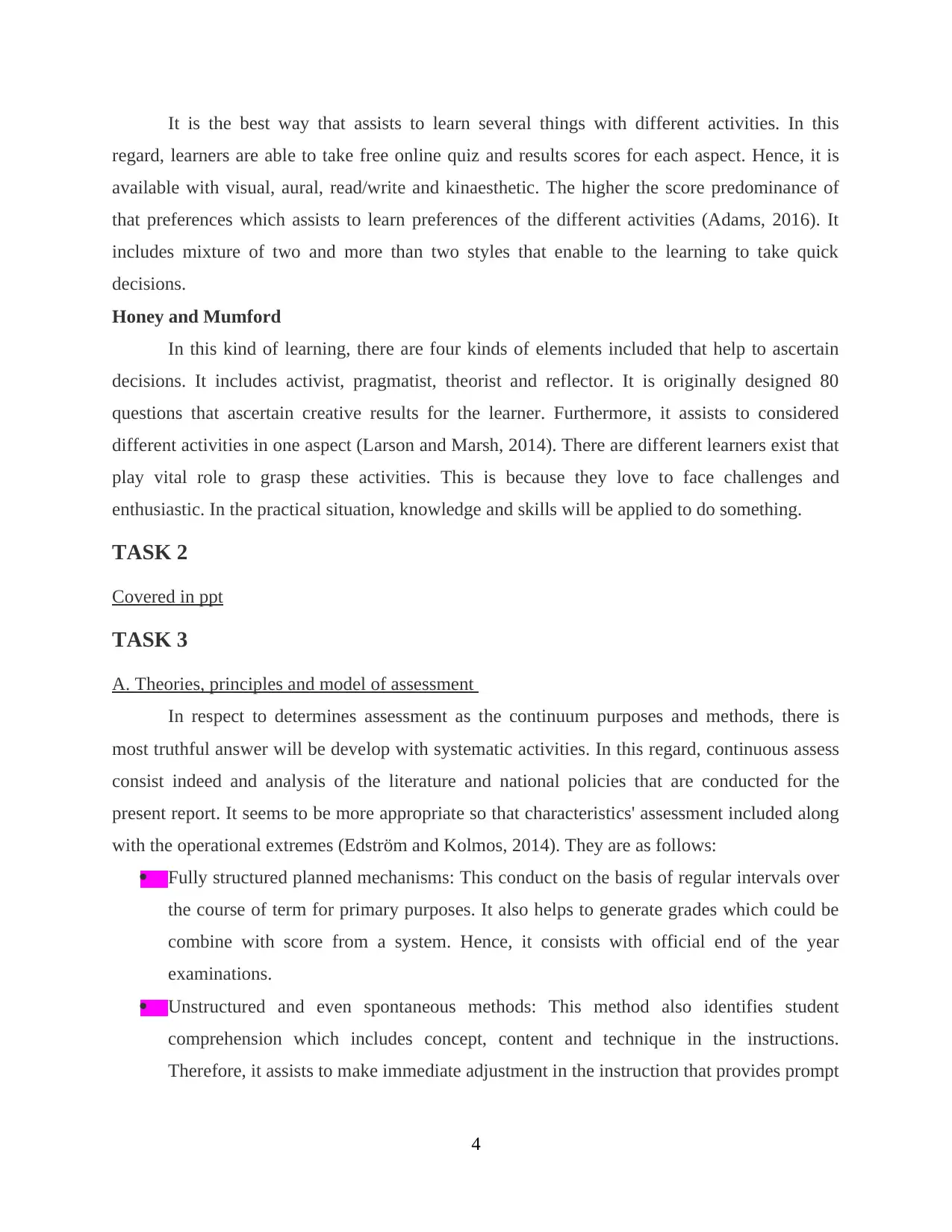
It is the best way that assists to learn several things with different activities. In this
regard, learners are able to take free online quiz and results scores for each aspect. Hence, it is
available with visual, aural, read/write and kinaesthetic. The higher the score predominance of
that preferences which assists to learn preferences of the different activities (Adams, 2016). It
includes mixture of two and more than two styles that enable to the learning to take quick
decisions.
Honey and Mumford
In this kind of learning, there are four kinds of elements included that help to ascertain
decisions. It includes activist, pragmatist, theorist and reflector. It is originally designed 80
questions that ascertain creative results for the learner. Furthermore, it assists to considered
different activities in one aspect (Larson and Marsh, 2014). There are different learners exist that
play vital role to grasp these activities. This is because they love to face challenges and
enthusiastic. In the practical situation, knowledge and skills will be applied to do something.
TASK 2
Covered in ppt
TASK 3
A. Theories, principles and model of assessment
In respect to determines assessment as the continuum purposes and methods, there is
most truthful answer will be develop with systematic activities. In this regard, continuous assess
consist indeed and analysis of the literature and national policies that are conducted for the
present report. It seems to be more appropriate so that characteristics' assessment included along
with the operational extremes (Edström and Kolmos, 2014). They are as follows:
Fully structured planned mechanisms: This conduct on the basis of regular intervals over
the course of term for primary purposes. It also helps to generate grades which could be
combine with score from a system. Hence, it consists with official end of the year
examinations.
Unstructured and even spontaneous methods: This method also identifies student
comprehension which includes concept, content and technique in the instructions.
Therefore, it assists to make immediate adjustment in the instruction that provides prompt
4
regard, learners are able to take free online quiz and results scores for each aspect. Hence, it is
available with visual, aural, read/write and kinaesthetic. The higher the score predominance of
that preferences which assists to learn preferences of the different activities (Adams, 2016). It
includes mixture of two and more than two styles that enable to the learning to take quick
decisions.
Honey and Mumford
In this kind of learning, there are four kinds of elements included that help to ascertain
decisions. It includes activist, pragmatist, theorist and reflector. It is originally designed 80
questions that ascertain creative results for the learner. Furthermore, it assists to considered
different activities in one aspect (Larson and Marsh, 2014). There are different learners exist that
play vital role to grasp these activities. This is because they love to face challenges and
enthusiastic. In the practical situation, knowledge and skills will be applied to do something.
TASK 2
Covered in ppt
TASK 3
A. Theories, principles and model of assessment
In respect to determines assessment as the continuum purposes and methods, there is
most truthful answer will be develop with systematic activities. In this regard, continuous assess
consist indeed and analysis of the literature and national policies that are conducted for the
present report. It seems to be more appropriate so that characteristics' assessment included along
with the operational extremes (Edström and Kolmos, 2014). They are as follows:
Fully structured planned mechanisms: This conduct on the basis of regular intervals over
the course of term for primary purposes. It also helps to generate grades which could be
combine with score from a system. Hence, it consists with official end of the year
examinations.
Unstructured and even spontaneous methods: This method also identifies student
comprehension which includes concept, content and technique in the instructions.
Therefore, it assists to make immediate adjustment in the instruction that provides prompt
4
⊘ This is a preview!⊘
Do you want full access?
Subscribe today to unlock all pages.

Trusted by 1+ million students worldwide
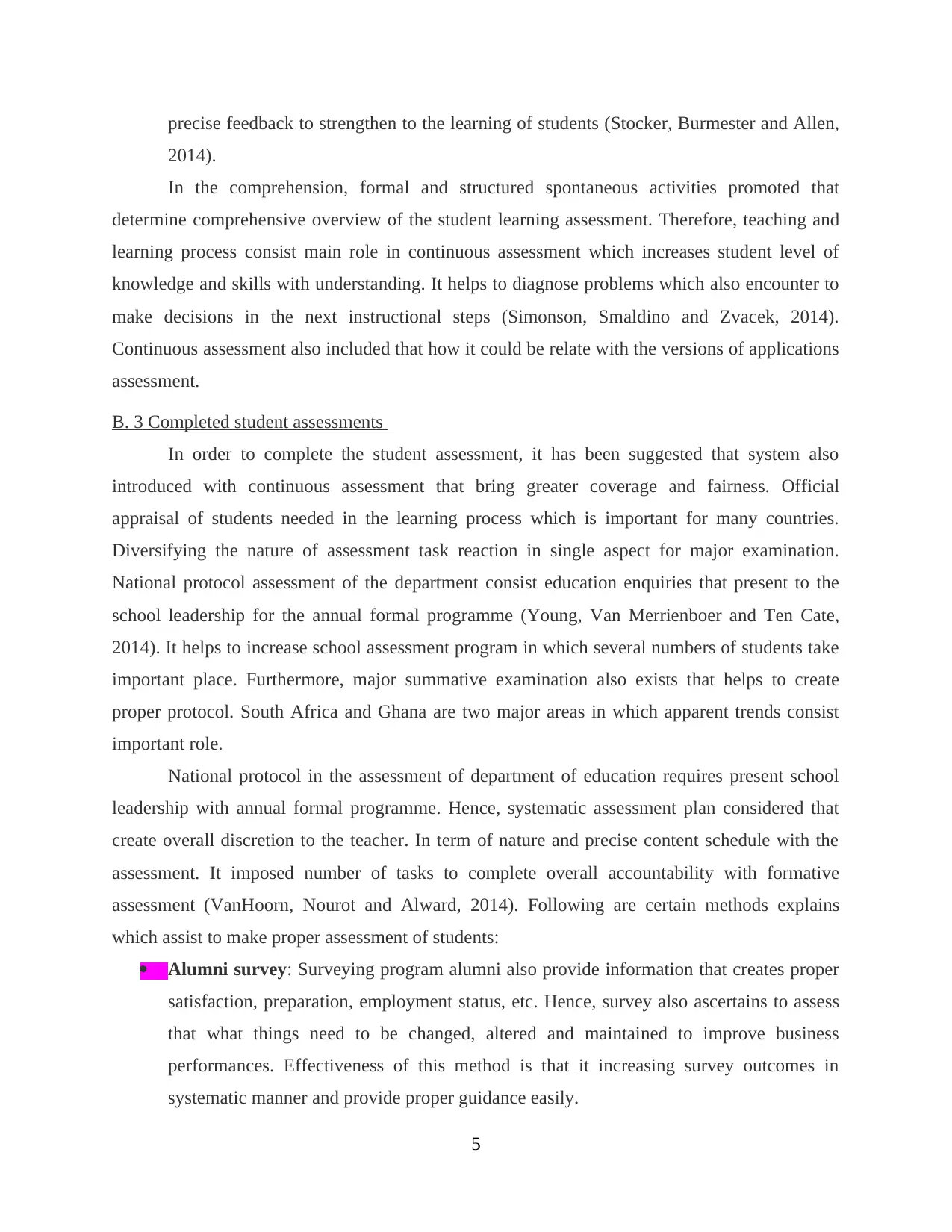
precise feedback to strengthen to the learning of students (Stocker, Burmester and Allen,
2014).
In the comprehension, formal and structured spontaneous activities promoted that
determine comprehensive overview of the student learning assessment. Therefore, teaching and
learning process consist main role in continuous assessment which increases student level of
knowledge and skills with understanding. It helps to diagnose problems which also encounter to
make decisions in the next instructional steps (Simonson, Smaldino and Zvacek, 2014).
Continuous assessment also included that how it could be relate with the versions of applications
assessment.
B. 3 Completed student assessments
In order to complete the student assessment, it has been suggested that system also
introduced with continuous assessment that bring greater coverage and fairness. Official
appraisal of students needed in the learning process which is important for many countries.
Diversifying the nature of assessment task reaction in single aspect for major examination.
National protocol assessment of the department consist education enquiries that present to the
school leadership for the annual formal programme (Young, Van Merrienboer and Ten Cate,
2014). It helps to increase school assessment program in which several numbers of students take
important place. Furthermore, major summative examination also exists that helps to create
proper protocol. South Africa and Ghana are two major areas in which apparent trends consist
important role.
National protocol in the assessment of department of education requires present school
leadership with annual formal programme. Hence, systematic assessment plan considered that
create overall discretion to the teacher. In term of nature and precise content schedule with the
assessment. It imposed number of tasks to complete overall accountability with formative
assessment (VanHoorn, Nourot and Alward, 2014). Following are certain methods explains
which assist to make proper assessment of students:
Alumni survey: Surveying program alumni also provide information that creates proper
satisfaction, preparation, employment status, etc. Hence, survey also ascertains to assess
that what things need to be changed, altered and maintained to improve business
performances. Effectiveness of this method is that it increasing survey outcomes in
systematic manner and provide proper guidance easily.
5
2014).
In the comprehension, formal and structured spontaneous activities promoted that
determine comprehensive overview of the student learning assessment. Therefore, teaching and
learning process consist main role in continuous assessment which increases student level of
knowledge and skills with understanding. It helps to diagnose problems which also encounter to
make decisions in the next instructional steps (Simonson, Smaldino and Zvacek, 2014).
Continuous assessment also included that how it could be relate with the versions of applications
assessment.
B. 3 Completed student assessments
In order to complete the student assessment, it has been suggested that system also
introduced with continuous assessment that bring greater coverage and fairness. Official
appraisal of students needed in the learning process which is important for many countries.
Diversifying the nature of assessment task reaction in single aspect for major examination.
National protocol assessment of the department consist education enquiries that present to the
school leadership for the annual formal programme (Young, Van Merrienboer and Ten Cate,
2014). It helps to increase school assessment program in which several numbers of students take
important place. Furthermore, major summative examination also exists that helps to create
proper protocol. South Africa and Ghana are two major areas in which apparent trends consist
important role.
National protocol in the assessment of department of education requires present school
leadership with annual formal programme. Hence, systematic assessment plan considered that
create overall discretion to the teacher. In term of nature and precise content schedule with the
assessment. It imposed number of tasks to complete overall accountability with formative
assessment (VanHoorn, Nourot and Alward, 2014). Following are certain methods explains
which assist to make proper assessment of students:
Alumni survey: Surveying program alumni also provide information that creates proper
satisfaction, preparation, employment status, etc. Hence, survey also ascertains to assess
that what things need to be changed, altered and maintained to improve business
performances. Effectiveness of this method is that it increasing survey outcomes in
systematic manner and provide proper guidance easily.
5
Paraphrase This Document
Need a fresh take? Get an instant paraphrase of this document with our AI Paraphraser
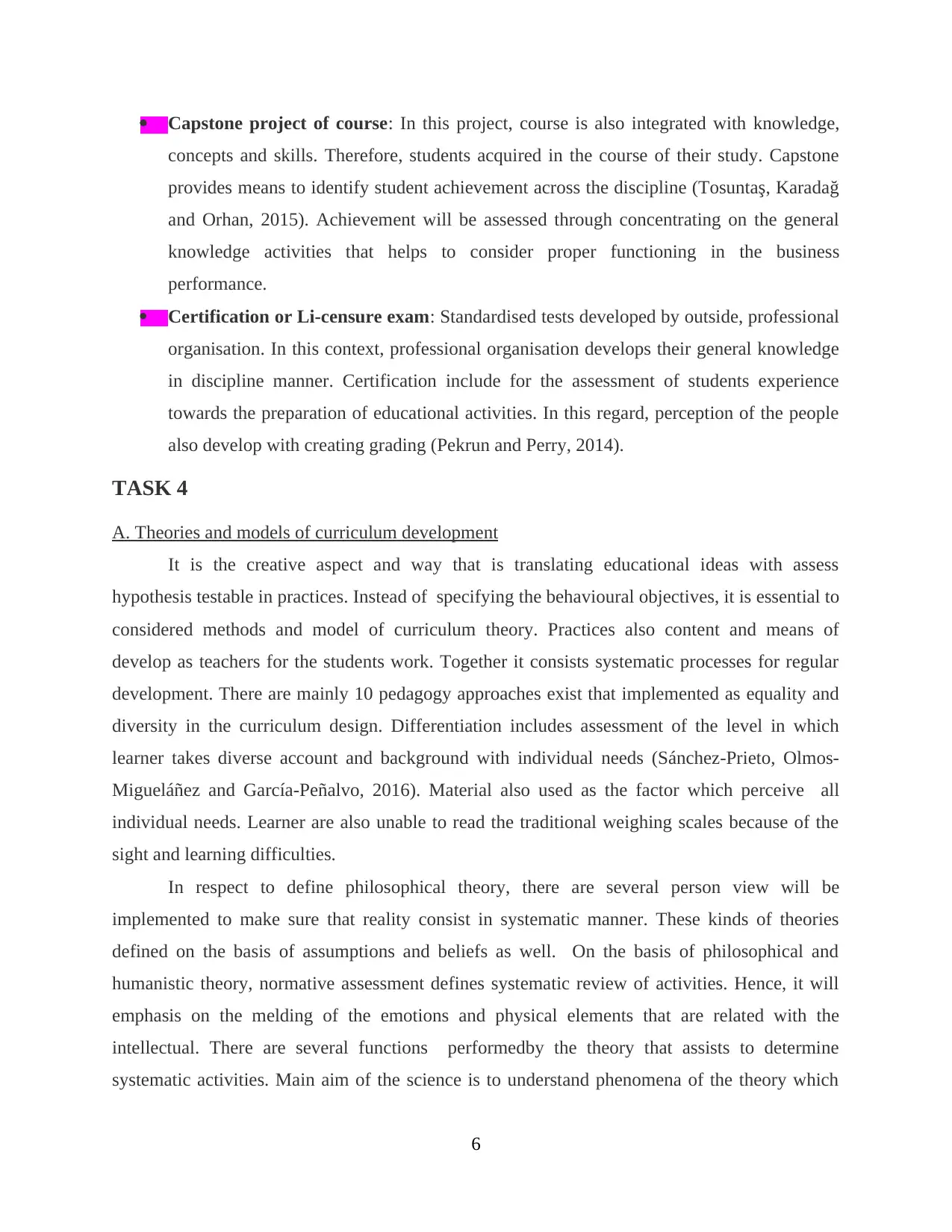
Capstone project of course: In this project, course is also integrated with knowledge,
concepts and skills. Therefore, students acquired in the course of their study. Capstone
provides means to identify student achievement across the discipline (Tosuntaş, Karadağ
and Orhan, 2015). Achievement will be assessed through concentrating on the general
knowledge activities that helps to consider proper functioning in the business
performance.
Certification or Li-censure exam: Standardised tests developed by outside, professional
organisation. In this context, professional organisation develops their general knowledge
in discipline manner. Certification include for the assessment of students experience
towards the preparation of educational activities. In this regard, perception of the people
also develop with creating grading (Pekrun and Perry, 2014).
TASK 4
A. Theories and models of curriculum development
It is the creative aspect and way that is translating educational ideas with assess
hypothesis testable in practices. Instead of specifying the behavioural objectives, it is essential to
considered methods and model of curriculum theory. Practices also content and means of
develop as teachers for the students work. Together it consists systematic processes for regular
development. There are mainly 10 pedagogy approaches exist that implemented as equality and
diversity in the curriculum design. Differentiation includes assessment of the level in which
learner takes diverse account and background with individual needs (Sánchez-Prieto, Olmos-
Migueláñez and García-Peñalvo, 2016). Material also used as the factor which perceive all
individual needs. Learner are also unable to read the traditional weighing scales because of the
sight and learning difficulties.
In respect to define philosophical theory, there are several person view will be
implemented to make sure that reality consist in systematic manner. These kinds of theories
defined on the basis of assumptions and beliefs as well. On the basis of philosophical and
humanistic theory, normative assessment defines systematic review of activities. Hence, it will
emphasis on the melding of the emotions and physical elements that are related with the
intellectual. There are several functions performedby the theory that assists to determine
systematic activities. Main aim of the science is to understand phenomena of the theory which
6
concepts and skills. Therefore, students acquired in the course of their study. Capstone
provides means to identify student achievement across the discipline (Tosuntaş, Karadağ
and Orhan, 2015). Achievement will be assessed through concentrating on the general
knowledge activities that helps to consider proper functioning in the business
performance.
Certification or Li-censure exam: Standardised tests developed by outside, professional
organisation. In this context, professional organisation develops their general knowledge
in discipline manner. Certification include for the assessment of students experience
towards the preparation of educational activities. In this regard, perception of the people
also develop with creating grading (Pekrun and Perry, 2014).
TASK 4
A. Theories and models of curriculum development
It is the creative aspect and way that is translating educational ideas with assess
hypothesis testable in practices. Instead of specifying the behavioural objectives, it is essential to
considered methods and model of curriculum theory. Practices also content and means of
develop as teachers for the students work. Together it consists systematic processes for regular
development. There are mainly 10 pedagogy approaches exist that implemented as equality and
diversity in the curriculum design. Differentiation includes assessment of the level in which
learner takes diverse account and background with individual needs (Sánchez-Prieto, Olmos-
Migueláñez and García-Peñalvo, 2016). Material also used as the factor which perceive all
individual needs. Learner are also unable to read the traditional weighing scales because of the
sight and learning difficulties.
In respect to define philosophical theory, there are several person view will be
implemented to make sure that reality consist in systematic manner. These kinds of theories
defined on the basis of assumptions and beliefs as well. On the basis of philosophical and
humanistic theory, normative assessment defines systematic review of activities. Hence, it will
emphasis on the melding of the emotions and physical elements that are related with the
intellectual. There are several functions performedby the theory that assists to determine
systematic activities. Main aim of the science is to understand phenomena of the theory which
6
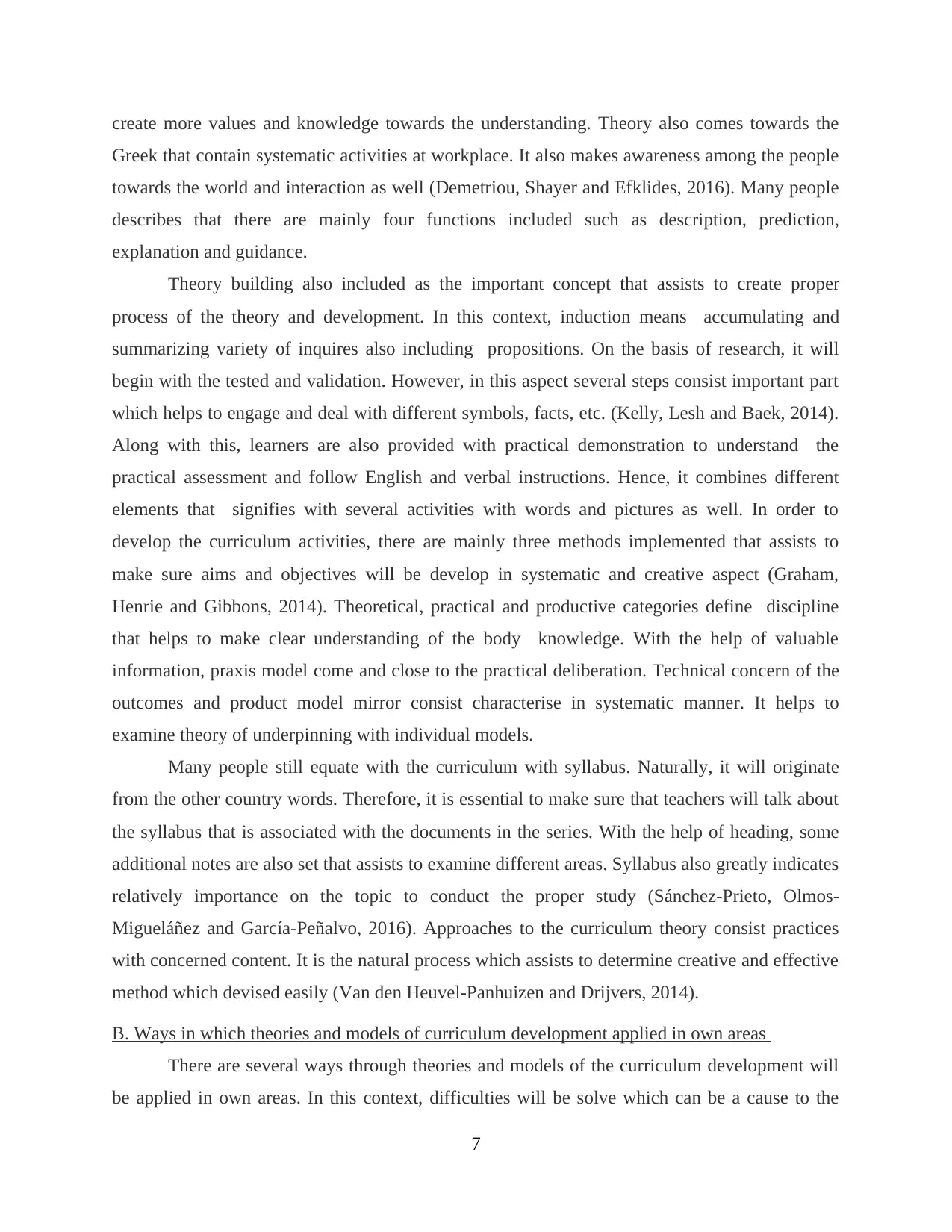
create more values and knowledge towards the understanding. Theory also comes towards the
Greek that contain systematic activities at workplace. It also makes awareness among the people
towards the world and interaction as well (Demetriou, Shayer and Efklides, 2016). Many people
describes that there are mainly four functions included such as description, prediction,
explanation and guidance.
Theory building also included as the important concept that assists to create proper
process of the theory and development. In this context, induction means accumulating and
summarizing variety of inquires also including propositions. On the basis of research, it will
begin with the tested and validation. However, in this aspect several steps consist important part
which helps to engage and deal with different symbols, facts, etc. (Kelly, Lesh and Baek, 2014).
Along with this, learners are also provided with practical demonstration to understand the
practical assessment and follow English and verbal instructions. Hence, it combines different
elements that signifies with several activities with words and pictures as well. In order to
develop the curriculum activities, there are mainly three methods implemented that assists to
make sure aims and objectives will be develop in systematic and creative aspect (Graham,
Henrie and Gibbons, 2014). Theoretical, practical and productive categories define discipline
that helps to make clear understanding of the body knowledge. With the help of valuable
information, praxis model come and close to the practical deliberation. Technical concern of the
outcomes and product model mirror consist characterise in systematic manner. It helps to
examine theory of underpinning with individual models.
Many people still equate with the curriculum with syllabus. Naturally, it will originate
from the other country words. Therefore, it is essential to make sure that teachers will talk about
the syllabus that is associated with the documents in the series. With the help of heading, some
additional notes are also set that assists to examine different areas. Syllabus also greatly indicates
relatively importance on the topic to conduct the proper study (Sánchez-Prieto, Olmos-
Migueláñez and García-Peñalvo, 2016). Approaches to the curriculum theory consist practices
with concerned content. It is the natural process which assists to determine creative and effective
method which devised easily (Van den Heuvel-Panhuizen and Drijvers, 2014).
B. Ways in which theories and models of curriculum development applied in own areas
There are several ways through theories and models of the curriculum development will
be applied in own areas. In this context, difficulties will be solve which can be a cause to the
7
Greek that contain systematic activities at workplace. It also makes awareness among the people
towards the world and interaction as well (Demetriou, Shayer and Efklides, 2016). Many people
describes that there are mainly four functions included such as description, prediction,
explanation and guidance.
Theory building also included as the important concept that assists to create proper
process of the theory and development. In this context, induction means accumulating and
summarizing variety of inquires also including propositions. On the basis of research, it will
begin with the tested and validation. However, in this aspect several steps consist important part
which helps to engage and deal with different symbols, facts, etc. (Kelly, Lesh and Baek, 2014).
Along with this, learners are also provided with practical demonstration to understand the
practical assessment and follow English and verbal instructions. Hence, it combines different
elements that signifies with several activities with words and pictures as well. In order to
develop the curriculum activities, there are mainly three methods implemented that assists to
make sure aims and objectives will be develop in systematic and creative aspect (Graham,
Henrie and Gibbons, 2014). Theoretical, practical and productive categories define discipline
that helps to make clear understanding of the body knowledge. With the help of valuable
information, praxis model come and close to the practical deliberation. Technical concern of the
outcomes and product model mirror consist characterise in systematic manner. It helps to
examine theory of underpinning with individual models.
Many people still equate with the curriculum with syllabus. Naturally, it will originate
from the other country words. Therefore, it is essential to make sure that teachers will talk about
the syllabus that is associated with the documents in the series. With the help of heading, some
additional notes are also set that assists to examine different areas. Syllabus also greatly indicates
relatively importance on the topic to conduct the proper study (Sánchez-Prieto, Olmos-
Migueláñez and García-Peñalvo, 2016). Approaches to the curriculum theory consist practices
with concerned content. It is the natural process which assists to determine creative and effective
method which devised easily (Van den Heuvel-Panhuizen and Drijvers, 2014).
B. Ways in which theories and models of curriculum development applied in own areas
There are several ways through theories and models of the curriculum development will
be applied in own areas. In this context, difficulties will be solve which can be a cause to the
7
⊘ This is a preview!⊘
Do you want full access?
Subscribe today to unlock all pages.

Trusted by 1+ million students worldwide
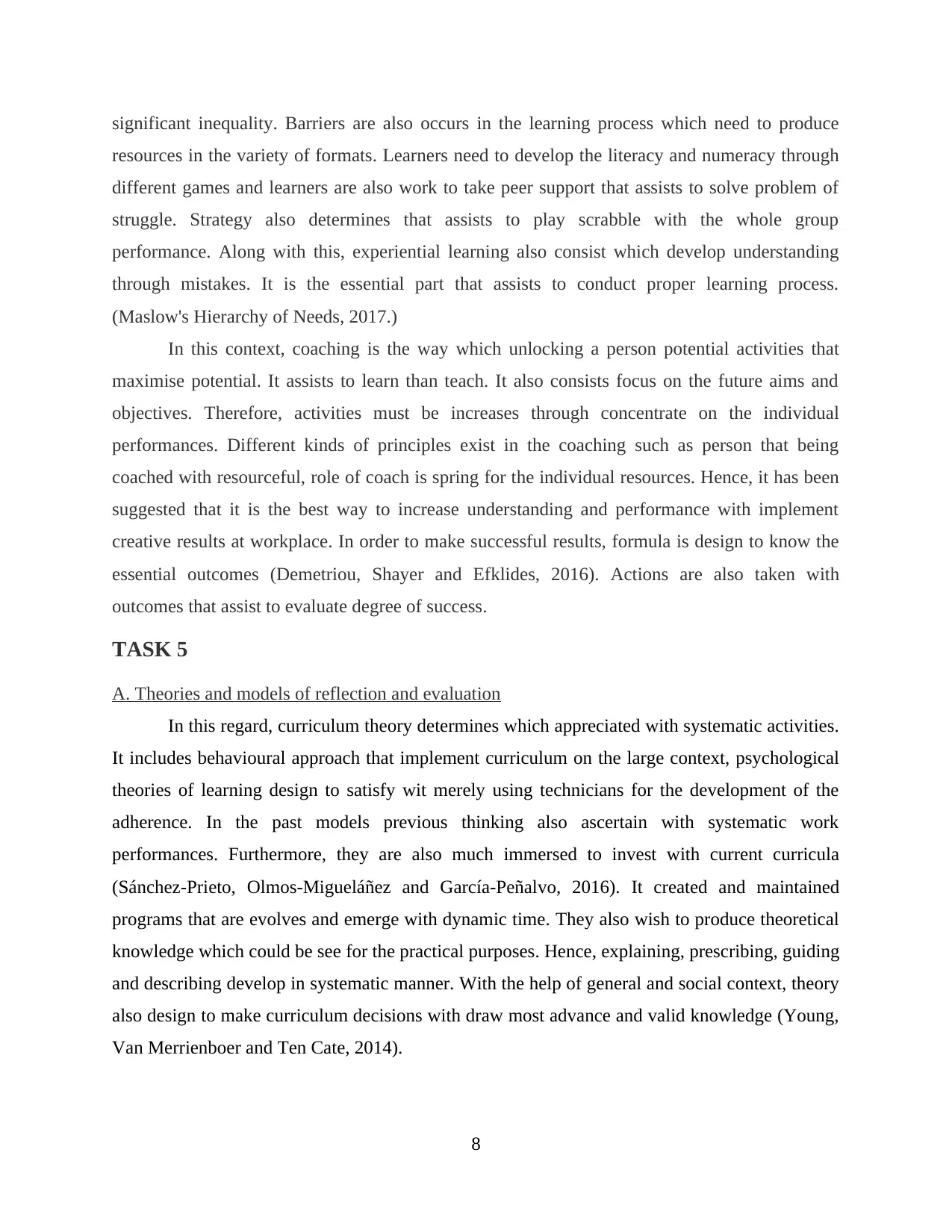
significant inequality. Barriers are also occurs in the learning process which need to produce
resources in the variety of formats. Learners need to develop the literacy and numeracy through
different games and learners are also work to take peer support that assists to solve problem of
struggle. Strategy also determines that assists to play scrabble with the whole group
performance. Along with this, experiential learning also consist which develop understanding
through mistakes. It is the essential part that assists to conduct proper learning process.
(Maslow's Hierarchy of Needs, 2017.)
In this context, coaching is the way which unlocking a person potential activities that
maximise potential. It assists to learn than teach. It also consists focus on the future aims and
objectives. Therefore, activities must be increases through concentrate on the individual
performances. Different kinds of principles exist in the coaching such as person that being
coached with resourceful, role of coach is spring for the individual resources. Hence, it has been
suggested that it is the best way to increase understanding and performance with implement
creative results at workplace. In order to make successful results, formula is design to know the
essential outcomes (Demetriou, Shayer and Efklides, 2016). Actions are also taken with
outcomes that assist to evaluate degree of success.
TASK 5
A. Theories and models of reflection and evaluation
In this regard, curriculum theory determines which appreciated with systematic activities.
It includes behavioural approach that implement curriculum on the large context, psychological
theories of learning design to satisfy wit merely using technicians for the development of the
adherence. In the past models previous thinking also ascertain with systematic work
performances. Furthermore, they are also much immersed to invest with current curricula
(Sánchez-Prieto, Olmos-Migueláñez and García-Peñalvo, 2016). It created and maintained
programs that are evolves and emerge with dynamic time. They also wish to produce theoretical
knowledge which could be see for the practical purposes. Hence, explaining, prescribing, guiding
and describing develop in systematic manner. With the help of general and social context, theory
also design to make curriculum decisions with draw most advance and valid knowledge (Young,
Van Merrienboer and Ten Cate, 2014).
8
resources in the variety of formats. Learners need to develop the literacy and numeracy through
different games and learners are also work to take peer support that assists to solve problem of
struggle. Strategy also determines that assists to play scrabble with the whole group
performance. Along with this, experiential learning also consist which develop understanding
through mistakes. It is the essential part that assists to conduct proper learning process.
(Maslow's Hierarchy of Needs, 2017.)
In this context, coaching is the way which unlocking a person potential activities that
maximise potential. It assists to learn than teach. It also consists focus on the future aims and
objectives. Therefore, activities must be increases through concentrate on the individual
performances. Different kinds of principles exist in the coaching such as person that being
coached with resourceful, role of coach is spring for the individual resources. Hence, it has been
suggested that it is the best way to increase understanding and performance with implement
creative results at workplace. In order to make successful results, formula is design to know the
essential outcomes (Demetriou, Shayer and Efklides, 2016). Actions are also taken with
outcomes that assist to evaluate degree of success.
TASK 5
A. Theories and models of reflection and evaluation
In this regard, curriculum theory determines which appreciated with systematic activities.
It includes behavioural approach that implement curriculum on the large context, psychological
theories of learning design to satisfy wit merely using technicians for the development of the
adherence. In the past models previous thinking also ascertain with systematic work
performances. Furthermore, they are also much immersed to invest with current curricula
(Sánchez-Prieto, Olmos-Migueláñez and García-Peñalvo, 2016). It created and maintained
programs that are evolves and emerge with dynamic time. They also wish to produce theoretical
knowledge which could be see for the practical purposes. Hence, explaining, prescribing, guiding
and describing develop in systematic manner. With the help of general and social context, theory
also design to make curriculum decisions with draw most advance and valid knowledge (Young,
Van Merrienboer and Ten Cate, 2014).
8
Paraphrase This Document
Need a fresh take? Get an instant paraphrase of this document with our AI Paraphraser
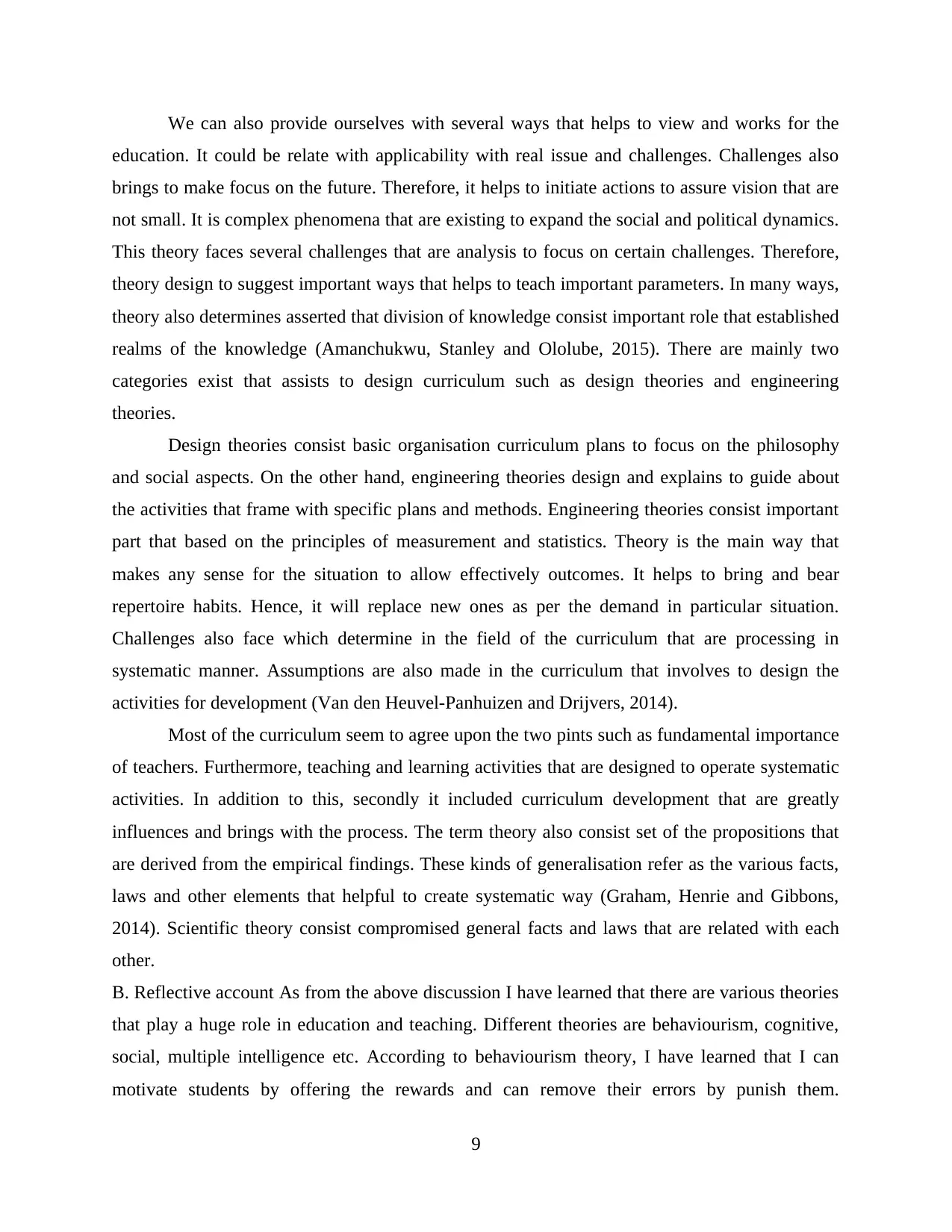
We can also provide ourselves with several ways that helps to view and works for the
education. It could be relate with applicability with real issue and challenges. Challenges also
brings to make focus on the future. Therefore, it helps to initiate actions to assure vision that are
not small. It is complex phenomena that are existing to expand the social and political dynamics.
This theory faces several challenges that are analysis to focus on certain challenges. Therefore,
theory design to suggest important ways that helps to teach important parameters. In many ways,
theory also determines asserted that division of knowledge consist important role that established
realms of the knowledge (Amanchukwu, Stanley and Ololube, 2015). There are mainly two
categories exist that assists to design curriculum such as design theories and engineering
theories.
Design theories consist basic organisation curriculum plans to focus on the philosophy
and social aspects. On the other hand, engineering theories design and explains to guide about
the activities that frame with specific plans and methods. Engineering theories consist important
part that based on the principles of measurement and statistics. Theory is the main way that
makes any sense for the situation to allow effectively outcomes. It helps to bring and bear
repertoire habits. Hence, it will replace new ones as per the demand in particular situation.
Challenges also face which determine in the field of the curriculum that are processing in
systematic manner. Assumptions are also made in the curriculum that involves to design the
activities for development (Van den Heuvel-Panhuizen and Drijvers, 2014).
Most of the curriculum seem to agree upon the two pints such as fundamental importance
of teachers. Furthermore, teaching and learning activities that are designed to operate systematic
activities. In addition to this, secondly it included curriculum development that are greatly
influences and brings with the process. The term theory also consist set of the propositions that
are derived from the empirical findings. These kinds of generalisation refer as the various facts,
laws and other elements that helpful to create systematic way (Graham, Henrie and Gibbons,
2014). Scientific theory consist compromised general facts and laws that are related with each
other.
B. Reflective account As from the above discussion I have learned that there are various theories
that play a huge role in education and teaching. Different theories are behaviourism, cognitive,
social, multiple intelligence etc. According to behaviourism theory, I have learned that I can
motivate students by offering the rewards and can remove their errors by punish them.
9
education. It could be relate with applicability with real issue and challenges. Challenges also
brings to make focus on the future. Therefore, it helps to initiate actions to assure vision that are
not small. It is complex phenomena that are existing to expand the social and political dynamics.
This theory faces several challenges that are analysis to focus on certain challenges. Therefore,
theory design to suggest important ways that helps to teach important parameters. In many ways,
theory also determines asserted that division of knowledge consist important role that established
realms of the knowledge (Amanchukwu, Stanley and Ololube, 2015). There are mainly two
categories exist that assists to design curriculum such as design theories and engineering
theories.
Design theories consist basic organisation curriculum plans to focus on the philosophy
and social aspects. On the other hand, engineering theories design and explains to guide about
the activities that frame with specific plans and methods. Engineering theories consist important
part that based on the principles of measurement and statistics. Theory is the main way that
makes any sense for the situation to allow effectively outcomes. It helps to bring and bear
repertoire habits. Hence, it will replace new ones as per the demand in particular situation.
Challenges also face which determine in the field of the curriculum that are processing in
systematic manner. Assumptions are also made in the curriculum that involves to design the
activities for development (Van den Heuvel-Panhuizen and Drijvers, 2014).
Most of the curriculum seem to agree upon the two pints such as fundamental importance
of teachers. Furthermore, teaching and learning activities that are designed to operate systematic
activities. In addition to this, secondly it included curriculum development that are greatly
influences and brings with the process. The term theory also consist set of the propositions that
are derived from the empirical findings. These kinds of generalisation refer as the various facts,
laws and other elements that helpful to create systematic way (Graham, Henrie and Gibbons,
2014). Scientific theory consist compromised general facts and laws that are related with each
other.
B. Reflective account As from the above discussion I have learned that there are various theories
that play a huge role in education and teaching. Different theories are behaviourism, cognitive,
social, multiple intelligence etc. According to behaviourism theory, I have learned that I can
motivate students by offering the rewards and can remove their errors by punish them.
9
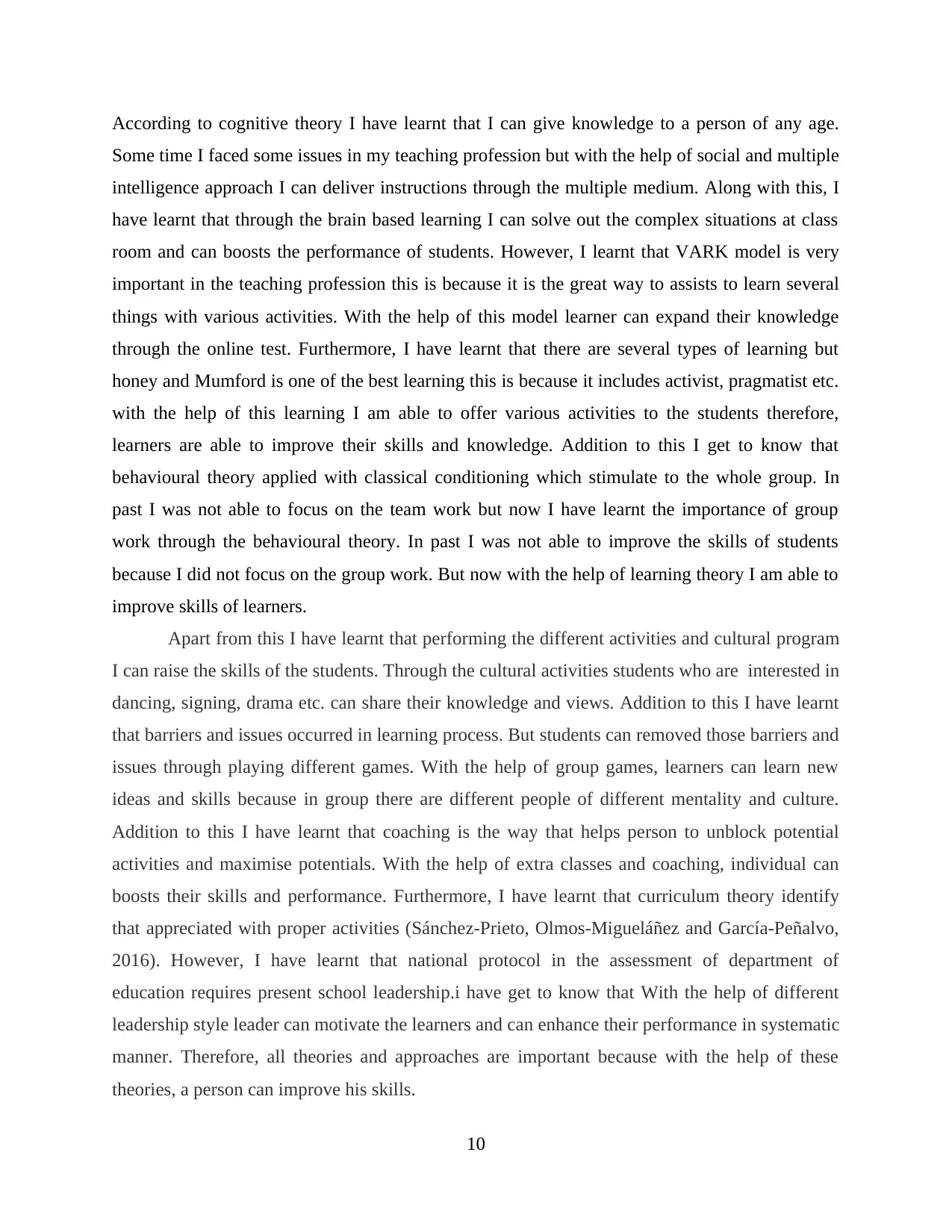
According to cognitive theory I have learnt that I can give knowledge to a person of any age.
Some time I faced some issues in my teaching profession but with the help of social and multiple
intelligence approach I can deliver instructions through the multiple medium. Along with this, I
have learnt that through the brain based learning I can solve out the complex situations at class
room and can boosts the performance of students. However, I learnt that VARK model is very
important in the teaching profession this is because it is the great way to assists to learn several
things with various activities. With the help of this model learner can expand their knowledge
through the online test. Furthermore, I have learnt that there are several types of learning but
honey and Mumford is one of the best learning this is because it includes activist, pragmatist etc.
with the help of this learning I am able to offer various activities to the students therefore,
learners are able to improve their skills and knowledge. Addition to this I get to know that
behavioural theory applied with classical conditioning which stimulate to the whole group. In
past I was not able to focus on the team work but now I have learnt the importance of group
work through the behavioural theory. In past I was not able to improve the skills of students
because I did not focus on the group work. But now with the help of learning theory I am able to
improve skills of learners.
Apart from this I have learnt that performing the different activities and cultural program
I can raise the skills of the students. Through the cultural activities students who are interested in
dancing, signing, drama etc. can share their knowledge and views. Addition to this I have learnt
that barriers and issues occurred in learning process. But students can removed those barriers and
issues through playing different games. With the help of group games, learners can learn new
ideas and skills because in group there are different people of different mentality and culture.
Addition to this I have learnt that coaching is the way that helps person to unblock potential
activities and maximise potentials. With the help of extra classes and coaching, individual can
boosts their skills and performance. Furthermore, I have learnt that curriculum theory identify
that appreciated with proper activities (Sánchez-Prieto, Olmos-Migueláñez and García-Peñalvo,
2016). However, I have learnt that national protocol in the assessment of department of
education requires present school leadership.i have get to know that With the help of different
leadership style leader can motivate the learners and can enhance their performance in systematic
manner. Therefore, all theories and approaches are important because with the help of these
theories, a person can improve his skills.
10
Some time I faced some issues in my teaching profession but with the help of social and multiple
intelligence approach I can deliver instructions through the multiple medium. Along with this, I
have learnt that through the brain based learning I can solve out the complex situations at class
room and can boosts the performance of students. However, I learnt that VARK model is very
important in the teaching profession this is because it is the great way to assists to learn several
things with various activities. With the help of this model learner can expand their knowledge
through the online test. Furthermore, I have learnt that there are several types of learning but
honey and Mumford is one of the best learning this is because it includes activist, pragmatist etc.
with the help of this learning I am able to offer various activities to the students therefore,
learners are able to improve their skills and knowledge. Addition to this I get to know that
behavioural theory applied with classical conditioning which stimulate to the whole group. In
past I was not able to focus on the team work but now I have learnt the importance of group
work through the behavioural theory. In past I was not able to improve the skills of students
because I did not focus on the group work. But now with the help of learning theory I am able to
improve skills of learners.
Apart from this I have learnt that performing the different activities and cultural program
I can raise the skills of the students. Through the cultural activities students who are interested in
dancing, signing, drama etc. can share their knowledge and views. Addition to this I have learnt
that barriers and issues occurred in learning process. But students can removed those barriers and
issues through playing different games. With the help of group games, learners can learn new
ideas and skills because in group there are different people of different mentality and culture.
Addition to this I have learnt that coaching is the way that helps person to unblock potential
activities and maximise potentials. With the help of extra classes and coaching, individual can
boosts their skills and performance. Furthermore, I have learnt that curriculum theory identify
that appreciated with proper activities (Sánchez-Prieto, Olmos-Migueláñez and García-Peñalvo,
2016). However, I have learnt that national protocol in the assessment of department of
education requires present school leadership.i have get to know that With the help of different
leadership style leader can motivate the learners and can enhance their performance in systematic
manner. Therefore, all theories and approaches are important because with the help of these
theories, a person can improve his skills.
10
⊘ This is a preview!⊘
Do you want full access?
Subscribe today to unlock all pages.

Trusted by 1+ million students worldwide
1 out of 15
Related Documents
Your All-in-One AI-Powered Toolkit for Academic Success.
+13062052269
info@desklib.com
Available 24*7 on WhatsApp / Email
![[object Object]](/_next/static/media/star-bottom.7253800d.svg)
Unlock your academic potential
Copyright © 2020–2025 A2Z Services. All Rights Reserved. Developed and managed by ZUCOL.




